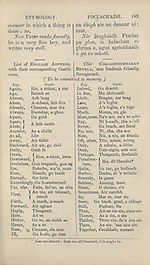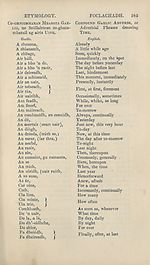Books and other items printed in Gaelic from 1841 to 1870 > Double grammar, of English and Gaelic, in which the principles of both languages are clearly explained
(186) Page 184
Download files
Complete book:
Individual page:
Thumbnail gallery: Grid view | List view

184 ETYMOLOGY.
Eng. Gaelic.
Too, Mar an ceudna, fos,
tuille is,
To & fro, H-uige’s uaithe
Thrice, Tri uairean, tri chuairt
Twice, Da uair
Thus, Mar so, air an ddigh so
Up, up. Suas gu h-ard ’naird
wards,
Viz. (ri- Is esin ri radh,eadhon
delicet)
Some adverbs are compared li
oftenest; soon, sooner, sooner.
Adjectives in English are
changed into Adverbs by
adding ly to them; as,
sweet, sweetly; glad, glad??/.
Adjectives in Gaelic are
used adverbially by pre¬
fixing gu to them ; as,
Gu binn, melodiously; gu
boldly.
Most English words en
Nouns and Adjectives,
and also Adverbs, combined
with the Gaelic Article, and
with Prepositions, form
phrases of adverbial mean¬
ing.
There are many Adverbs
of this description, and
such as are commonly used
are given in the following
catalogue.
FOCLACHADH.
Eng. Gaelic.
Very,verily, Ro, fior, gu fior
Well, Seadh,romhath,bhuil
Where, C’ait, far
When, Cuin, ’nuair
Whence, Cia as, co as
While, ) Am feadh, re na h-
Whilst, j nine
Why C’arson,
Yea, yes, Seadh, ’se, tha
Yet, Fathast, osbarr
ce Adjectives; as, oflen, oftener,
Nithear Co-ghniomharan
de Bhuadharan ’sa Bheurla
le ly chur riu ; mar, bad,
bad??/; nice, nice??/.
Gnathaichear Buadharan
gu co-ghniomharail, ’sa
Ghaelig le roimh-chur na
smid gu riu ; mar,
h-olc, ill, badly; gu dana.
ling in ly are Adverbs.
Tha Ainmearan agus
Buadharan, agus fos Co-
ghniomharan, co-naisgte ris
a’ Phungar Ghaelig, agus
ri Roimhearan, a’ deanamh
shedllairtean,* aig am beil
seadh co-ghniomharail.
Thamoran cho-ghniomh-
aran de ’n dealbh so aim,
agus cuirear sios a mheud
’sa ghnathaichear gu trie,
anns a ehlar-ainm a leanas.
• Se6l*labhairt no gn&th-fhoca!.
Eng. Gaelic.
Too, Mar an ceudna, fos,
tuille is,
To & fro, H-uige’s uaithe
Thrice, Tri uairean, tri chuairt
Twice, Da uair
Thus, Mar so, air an ddigh so
Up, up. Suas gu h-ard ’naird
wards,
Viz. (ri- Is esin ri radh,eadhon
delicet)
Some adverbs are compared li
oftenest; soon, sooner, sooner.
Adjectives in English are
changed into Adverbs by
adding ly to them; as,
sweet, sweetly; glad, glad??/.
Adjectives in Gaelic are
used adverbially by pre¬
fixing gu to them ; as,
Gu binn, melodiously; gu
boldly.
Most English words en
Nouns and Adjectives,
and also Adverbs, combined
with the Gaelic Article, and
with Prepositions, form
phrases of adverbial mean¬
ing.
There are many Adverbs
of this description, and
such as are commonly used
are given in the following
catalogue.
FOCLACHADH.
Eng. Gaelic.
Very,verily, Ro, fior, gu fior
Well, Seadh,romhath,bhuil
Where, C’ait, far
When, Cuin, ’nuair
Whence, Cia as, co as
While, ) Am feadh, re na h-
Whilst, j nine
Why C’arson,
Yea, yes, Seadh, ’se, tha
Yet, Fathast, osbarr
ce Adjectives; as, oflen, oftener,
Nithear Co-ghniomharan
de Bhuadharan ’sa Bheurla
le ly chur riu ; mar, bad,
bad??/; nice, nice??/.
Gnathaichear Buadharan
gu co-ghniomharail, ’sa
Ghaelig le roimh-chur na
smid gu riu ; mar,
h-olc, ill, badly; gu dana.
ling in ly are Adverbs.
Tha Ainmearan agus
Buadharan, agus fos Co-
ghniomharan, co-naisgte ris
a’ Phungar Ghaelig, agus
ri Roimhearan, a’ deanamh
shedllairtean,* aig am beil
seadh co-ghniomharail.
Thamoran cho-ghniomh-
aran de ’n dealbh so aim,
agus cuirear sios a mheud
’sa ghnathaichear gu trie,
anns a ehlar-ainm a leanas.
• Se6l*labhairt no gn&th-fhoca!.
Set display mode to:
![]() Universal Viewer |
Universal Viewer | ![]() Mirador |
Large image | Transcription
Mirador |
Large image | Transcription
Images and transcriptions on this page, including medium image downloads, may be used under the Creative Commons Attribution 4.0 International Licence unless otherwise stated. ![]()
| Permanent URL | https://digital.nls.uk/106541997 |
|---|
| Description | Out-of-copyright books printed in Gaelic between 1631 and 1900. Also some pamphlets and chapbooks. Includes poetry and songs, religious books such as catechisms and hymns, and different editions of the Bible and the Psalms. Also includes the second book ever published in Gaelic in 1631. |
|---|

